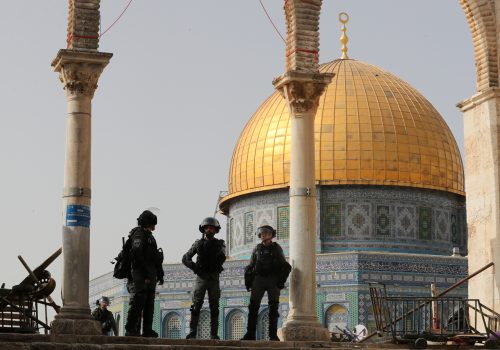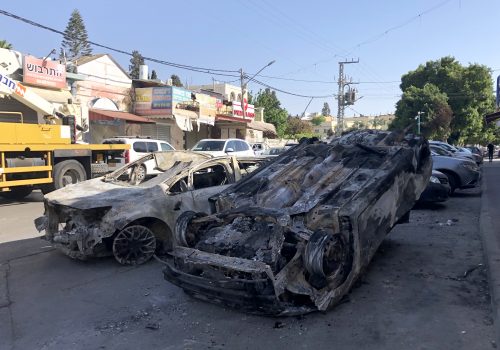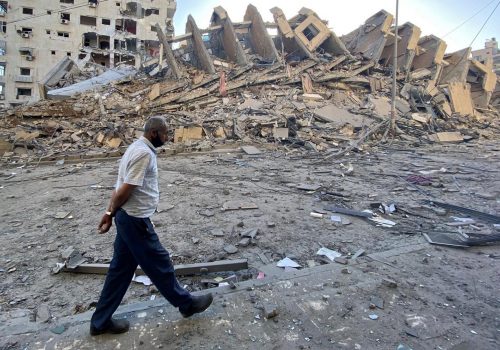For all its ‘achievements’ in battle, Israel is losing the war
After eleven days of fighting between Israel and Hamas, the latest round of violence has come to a welcome, if anticlimactic, halt. As was expected, both sides proclaimed victory.
Hamas will declare that it is the sole defender of Jerusalem and the enabler of economic reconstruction in the Gaza Strip. They have also put Palestine back on the agenda globally.
For his part, Israeli Prime Minister Benjamin Netanyahu can boast of Israel’s military achievements in a defensive strike: Iron Dome proved 90 percent effective as Hamas fired more than four thousand rockets into Israel—of which 680 landed in Gaza. Israeli security officials proclaimed success in restoring quiet and establishing “deterrence.” They have depleted Hamas’ arsenal, killed around twenty senior operatives, and leveled roughly one hundred kilometers of what has been dubbed the Gazan “metro”—a network of underground tunnels from which Hamas launches its strikes.
Yet, for all these “achievements” in battle, Israel is losing the war.
Sixteen years have passed since Israel withdrew from Gaza and dismantled all settlements there. Fourteen years have also passed since Hamas took control of the area in the Battle of Gaza against the Palestinian Authority (PA) that killed more than one hundred Palestinians. Since then, more than six thousand people have died and untold billions of dollars have been spent building up Hamas’ arsenal, fortifying Israel against the threat, and reconstructing Gaza. And, while the situation continues to deteriorate, neither side has undertaken any meaningful reflection on how to stem the tide.
From the moment that Hamas launched missiles into Israel on May 10, the international community—the United States notwithstanding—began calls for restraint. But the debate in Israel sounded profoundly different. The question in these moments is never whether Israel should respond, but rather how much more forcefully? How many gains can be extracted in the short term? How much can we deplete Hamas’ capability, and how quickly? How much time will the US give us? Even after a ceasefire is reached, the same line of questioning persists. Israel has long tolerated smaller provocations from Gaza like launching incendiary balloon explosives and weaponized kites, but now Israelis pundits debate whether this type of limited fire will be allowed to continue or whether Israel will start to respond.
While in times of crisis, questions like these may make sense—in times of quiet, they do not. This month’s fighting was multifrontal—with missiles entering Israel from Lebanon, Syria, and Gaza—but, perhaps most dangerously, fighting between Jews and Arabs erupted in Israel’s front yard, a preview, as the Brooking Institute’s Tamara CofmanWittes astutely points out, of what a one-state outcome could look like. And, while the sides may retreat to their corners to entrench more deeply into their existing positions, now, in a moment of quiet, it is time for Israelis to start asking the difficult questions.
What is Israel’s long-term strategy for resolving this conflict? How can Israel survive as a Jewish and democratic state absent a two-state outcome? If they do not wish to integrate their Palestinian neighbors, how will they separate themselves from them? How much longer can they cope with the endless distress—and volatility—in the Palestinian territories? Moreover, as accusations of “apartheid” become increasingly mainstreamed, what will Israel do to ensure that isn’t the case? Even if Israel can withstand the violence and international isolation and economic toll, they still cannot wish the Palestinians away.
Israel’s approach to Hamas epitomizes the complexity of Israel’s dilemmas, but also its short-sightedness. In each battle, the security establishment pursues limited objectives to deplete the group’s arsenal and secure a short-term quiet. The alternatives—destroying or integrating Hamas—are considerably harder to swallow. Destruction, Israel understands, could yield even greater instability, or create a power vacuum filled by even more extremist groups like Palestinian Islamic Jihad, any of which could force Israel to reoccupy the Gaza Strip. At the same time, they have no desire to see Hamas, a US-designated terror organization, integrated into the PA . Nevertheless, each round of fighting and subsequent ceasefire rewards Hamas at the expense of a PA whose peaceful approach to the conflict—however flawed—has delivered nothing. How does perpetuating this situation—and the violence it portends—advance Israel’s long-term aspirations for peace?
Throughout his time in office, Netanyahu has proven to be among the world’s greatest tacticians, but has failed to offer any long-term vision for his country. He has frequently sought short-term political gains—empowering right-wing extremists in Israel, antagonizing Democrats in Congress, undermining the PA—with little regard for the long-term impact. And, while Netanyahu may benefit from the political expediency posed both by the threat Israel faces but also by his unparalleled experience confronting those threats, he does so at the expense of Israel’s safety and security. Hamas’ deployment of UAVs, submarines, and tunnels prove that the organization has only gotten more sophisticated over the past decade despite a blockade. As Gideon Saar, a Netanyahu rival who defected from the Prime Minister’s Likud party, pointed out in the Yedioth Ahronoth newspaper, Hamas has evolved from a terrorist group to an army under Netanyahu’s watch. The same increase in capabilities can be said of Israel’s foes across the region.
The current realities on the ground are slowly eroding the possibility for a peace agreement. International criticism—or, in some cases, hatred—of Israel is now leaking into the mainstream American discourse and has become center stage on global social media platforms over the last two weeks. The message is not only one of condemnation, but rather vociferous demands for a one-state outcome that will, in reality, yield only greater violence and instability and the decimation of the Zionist dream. There are no easy answers to these questions and bold tradeoffs will be required. But refusing to grapple with even the most basic challenges ahead imperils the future of the Jewish state. When Israelis next head to the ballot box—which could be sooner rather than later at the rate things are going—the time has come to start asking.
Carmiel Arbit is a nonresident senior fellow for Middle East Programs at the Atlantic Council, and a co-founder of Key Bridge Strategies. She researches and writes on US-Israel relations and has consulted for NGOs around the world, including in Israel and the Palestinian Territories.
Image: Palestinian man inspects his destroyed factory by Israeli air strike. A ceasefire was reached late last week after 11 days of deadly violence between Israel and the Hamas movement which runs Gaza, stopping Israel's devastating bombardment on the overcrowded Palestinian coastal enclave which, according to the Gaza health ministry, killed 248 Palestinians, including 66 children, and wounded more than 1,900 people. Meanwhile, rockets from Gaza. (Photo by Ahmed Zakot / SOPA Images/Sipa USA)No Use Germany.


